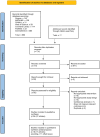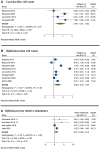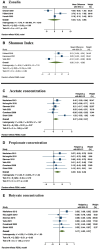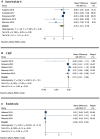The effect of oral synbiotics on the gut microbiota and inflammatory biomarkers in healthy adults: a systematic review and meta-analysis
- PMID: 38341803
- PMCID: PMC12086677
- DOI: 10.1093/nutrit/nuae002
The effect of oral synbiotics on the gut microbiota and inflammatory biomarkers in healthy adults: a systematic review and meta-analysis
Abstract
Context: Prior research has explored the effect of synbiotics, the combination of probiotics and prebiotics, on the gut microbiota in clinical populations. However, evidence related to the effect of synbiotics on the gut microbiota in healthy adults has not been reviewed to date.
Objective: A systematic review and meta-analysis was conducted to comprehensively investigate the effect of synbiotics on the gut microbiota and inflammatory markers in populations of healthy adults.
Data sources: Scopus, PubMed, Web of Science, ScienceDirect, MEDLINE, CINAHL, and The Cochrane Library were systematically searched to retrieve randomized controlled trials examining the primary outcome of gut microbiota or intestinal permeability changes after synbiotic consumption in healthy adults. Secondary outcomes of interest were short-chain fatty acids, inflammatory biomarkers, and gut microbiota diversity.
Data extraction: Weighted (WMD) or standardized mean difference (SMD) outcome data were pooled in restricted maximum likelihood models using random effects. Twenty-seven articles reporting on 26 studies met the eligibility criteria (n = 1319).
Data analysis: Meta-analyses of 16 studies showed synbiotics resulted in a significant increase in Lactobacillus cell count (SMD, 0.74; 95% confidence interval [CI], 0.15, 1.33; P = 0.01) and propionate concentration (SMD, 0.22; 95% CI, 0.02, 0.43; P = 0.03) compared with controls. A trend for an increase in Bifidobacterium relative abundance (WMD, 0.97; 95% CI, 0.42, 2.52; P = 0.10) and cell count (SMD, 0.82; 95% CI, 0.13, 1.88; P = 0.06) was seen. No significant differences in α-diversity, acetate, butyrate, zonulin, IL-6, CRP, or endotoxins were observed.
Conclusion: This review demonstrates that synbiotics modulate the gut microbiota by increasing Lactobacillus and propionate across various healthy adult populations, and may result in increased Bifidobacterium. Significant variations in synbiotic type, dose, and duration should be considered as limitations when applying findings to clinical practice.
Systematic review registration: PROSPERO no. CRD42021284033.
Keywords: gut microbiome; gut microbiota; healthy adult; inflammation; prebiotic; probiotic; symbiotic.
© The Author(s) 2024. Published by Oxford University Press on behalf of the International Life Sciences Institute.
Figures





Similar articles
-
The effect of probiotics, prebiotics or synbiotics on metabolic outcomes in individuals with diabetes: a systematic review and meta-analysis.Diabetologia. 2021 Jan;64(1):26-41. doi: 10.1007/s00125-020-05295-1. Epub 2020 Oct 13. Diabetologia. 2021. PMID: 33047170
-
Efficacy of probiotic, prebiotic, and synbiotics supplements in individuals with anemia: a systematic review and meta-analysis of randomized controlled trials.BMC Gastroenterol. 2024 Dec 23;24(1):472. doi: 10.1186/s12876-024-03562-8. BMC Gastroenterol. 2024. PMID: 39716076 Free PMC article.
-
Prebiotic, Probiotic, and Synbiotic Supplementation in Chronic Kidney Disease: A Systematic Review and Meta-analysis.J Ren Nutr. 2019 May;29(3):209-220. doi: 10.1053/j.jrn.2018.08.008. Epub 2018 Oct 23. J Ren Nutr. 2019. PMID: 30366767
-
Reinforcing gut integrity: A systematic review and meta-analysis of clinical trials assessing probiotics, synbiotics, and prebiotics on intestinal permeability markers.Pharmacol Res. 2025 Jun;216:107780. doi: 10.1016/j.phrs.2025.107780. Epub 2025 May 15. Pharmacol Res. 2025. PMID: 40378939
-
The effect of probiotic and synbiotic supplementation on biomarkers of inflammation and oxidative stress in diabetic patients: A systematic review and meta-analysis of randomized controlled trials.Pharmacol Res. 2019 Apr;142:303-313. doi: 10.1016/j.phrs.2019.02.016. Epub 2019 Feb 19. Pharmacol Res. 2019. PMID: 30794924
Cited by
-
The Contribution of Precision Nutrition Intervention in Subfertile Couples.Nutrients. 2024 Dec 30;17(1):103. doi: 10.3390/nu17010103. Nutrients. 2024. PMID: 39796537 Free PMC article. Review.
-
Synergistic defecation effects of Bifidobacterium animalis subsp. lactis BL-99 and fructooligosaccharide by modulating gut microbiota.Front Immunol. 2025 Jan 9;15:1520296. doi: 10.3389/fimmu.2024.1520296. eCollection 2024. Front Immunol. 2025. PMID: 39850898 Free PMC article.
-
Microbiota and Inflammatory Markers: A Review of Their Interplay, Clinical Implications, and Metabolic Disorders.Int J Mol Sci. 2025 Feb 19;26(4):1773. doi: 10.3390/ijms26041773. Int J Mol Sci. 2025. PMID: 40004236 Free PMC article. Review.
References
-
- Chr. Hansen Holding A/S. New Study of Consumer Understanding of Probiotics Points to Significant Opportunities for the Food Industry. Denmark: Chr. Hansen Holding A/S; 2022.
-
- Hill C, Guarner F, Reid G, et al. Expert consensus document: the International Scientific Association for Probiotics and Prebiotics consensus statement on the scope and appropriate use of the term probiotic. Nat Rev Gastroenterol Hepatol. 2014;11:506–514. - PubMed
Publication types
MeSH terms
Substances
Grants and funding
LinkOut - more resources
Full Text Sources
Research Materials
Miscellaneous

